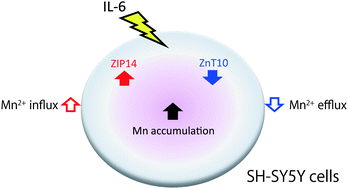Interleukin-6 enhances manganese accumulation in SH-SY5Y cells: implications of the up-regulation of ZIP14 and the down-regulation of ZnT10
Abstract
Exposure to an excess amount of manganese causes neurological symptoms similar to Parkinson's disease. Zinc transporters such as Zrt, Irt-related protein 8 (ZIP8), and ZIP14 have been shown to have affinities for Mn2+ as well as Zn2+, but their roles in Mn2+ uptake in neuronal cells remain unclear. Recent studies have shown that another zinc transporter ZnT10 may be involved in manganese excretion. Here we examined the roles of ZIP8, ZIP14, and ZnT10 in the transport of manganese in human SH-SY5Y neuroblastoma cells. The introduction of siRNA of ZIP14 decreased the uptake of Mn2+, suggesting a significant role of ZIP14 in Mn2+ uptake in SH-SY5Y cells. The pretreatment of SH-SY5Y cells with interleukin-6 (IL-6) markedly increased the accumulation of manganese to approx. 3-fold that of the control, which could be partly explained by the increased uptake of Mn2+ due to the up-regulation of ZIP14 by IL-6. The treatment of SH-SH5Y cells with IL-6 clearly decreased both the mRNA and protein levels of ZnT10 with a concomitant decrease in the manganese excretion efficiency. These results suggest that both the up-regulation of ZIP14 and the down-regulation of ZnT10 by IL-6 might have enhanced the accumulation of manganese in SH-SY5Y cells. Our results provide new insight into the roles of zinc transporters in the aberrant manganese accumulation in neuronal cells, particularly in the presence of inflammatory cytokines such as IL-6.


 Please wait while we load your content...
Please wait while we load your content...